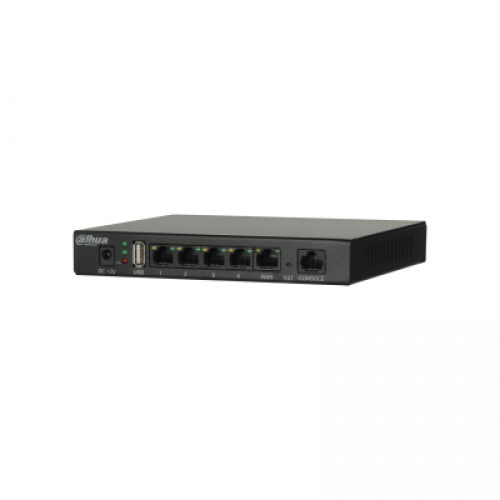Model
| DH-PFM888S-AC
|
Hardware
| CPU
| IPQ4028
|
RAM
| 256MB
|
ROM
| 256MB
|
Interfaces
| 10/100/1000M Base-TX *5
USB *1
Console *1
|
Dimension
| 170×160×34 (mm)
|
Power supply
| DC 12V/2A
|
Working temperature
| -10℃~55℃
|
Working humidity
| 5~95%RH
|
Performance
| Devices managed
| 256
|
Templates
| 256
|
Clients
| 8192
|
Access management
| IP
| Supports modifying the login IP address
|
User name/password
| Supports modifying the user name and password to login web
|
Language
| English, Chinese
|
Login limit
| Only one user is allowed to login and the former user will be logged out if new user logins.
|
Access limit
| For user who haven’t login, he will be redirected to login page if he visits any other URL.
|
Statistics
| Platform
| IP address, name of the platform, available memory, running time, CPU, usage of the memory, system time
|
Devices
| Total devices, online devices, offline devices
|
Clients
| Total clients, online clients, offline clients
|
Device management
| Status of access points
| Display online, offline, unregistered, upgrading, configuring, fail to upgrade, etc.
|
Name of access points
| Display device name of the access points
|
Model of access points
| Display the model of the access points
|
IP address of access points
| Display the IP address of access points (Supports modify the IP address of access points)
|
MAC address of access points
| Display the MAC address of the access points
|
Software version of access points
| Display the software version of access points and supports manual upgrade the software (need upload the software in advance)
|
Run time of access points
| Display the run time of access points
|
Group name of access points
| Display the group name of access points (display empty if there is no group)
|
Template name of access points
| Display the template name which access points are using now. When the device goes online for the first time, it shows unregistered and empty template name.
|
Device management
| Wireless status of access points
| Display the wireless parameters of access points: type, region, mode, transmit power, channel, bandwidth, SSID
|
Wireless mode of access points
| Display the wireless mode of access points
|
Position of access points
| Display the position of access points
|
Drop-down menu of access points
| Display the status of access points, device name, model, IP address, MAC address, software version, run time, signal strength, wireless speed, template name, wireless service, wireless mode, position, etc.
|
Client management
| Client list
| Display online clients
|
Client status
| Display online, offline, unregistered, upgrading, configuring, fail to upgrade, fail to configure, etc.
|
Client IP address
| Display the IP addresses of clients
|
Client MAC address
| Display the MAC addresses of clients
|
Client type
| Display client type: Android/iPhone/PC
|
Client signal
| Display the signal strength of clients
|
Client wireless standard
| Display the wireless standard which clients adopt
|
Client connection rate
| Display the connection rate of clients
|
SSID
| Display the SSID which client is connecting
|
Client’s user name
| Display the user name of client used to authentication
|
Client traffic
| Display the data traffic which clients have used
|
Client run time
| Display the online time of clients
|
Client group name
| Display the group that clients belong to (empty if there is no group)
|
Client’s AP
| Display the AP that clients connect
|
Clients’ AP’s MAC
| Display the MAC address of the AP that clients connect
|
Clients settings
| View, delete, modify group name and off-line clients which have already authenticated
|
Template management
| Display
| Display the templates which have been saved, the details including: template name, region, channel, bandwidth, transmit power level, max transmit power, SSID, encryption type
|
Template classification
| New, edit, display different templates according to different clients type
|
Modification
| Modify the templates which have been saved
|
New
| New templates, available configurations are shown below:
|
Region
| China, USA, Test Mode
|
Channel
| Select different channels according to regions
|
Bandwidth
| Supports 20/40/80MHz (5G-11AC mode)
|
Transmit power
| High/medium/low
|
Multi-VAPs
| AP supports max 8 VAP configuration, no TDMA;
Bridge supports 1 VAP configuration and TDMA.
|
SSID
| Supports SSID configuration
|
Hidden SSID
| Supports hidden SSID
|
Clients isolation
| Supports clients isolation
|
TDMA
| Support TDMA enable/disable
|
Template management
| Max clients limit
| Supports max clients limit from 1-127, default is 20
|
Authentication/encryption
| Supports authentication and encryption configuration
|
Restriction options
| Account control and MAC control
|
Online time
| Controlled by day/month
|
Traffic control
| Controlled by day/month
|
Client speed limit
| Speed limit from 64-102400
|
Auto-matching
| Auto-matching suitable template for each online clients
|
Image management
| Image list
| Displayed by list: image name, version, information, file size, update time, etc.
|
Upload
| Supports upload the image
|
Auto-upgrade
| If enable “auto-upgrade”, it will check whether the online AP matches and upgrade it automatically if it matches. It’s enabled by default.
|
Manual batch-upgrade
| Select image version and the online devices need to upgrade. The device will check whether it matches itself. If unmatched, it’ll show version unmatched;
If will show information when upgrading.
It shows upgrading successfully when it goes online after upgrading.
|
Device status when upgrading
| Check the status of upgrading device, including MAC, result, current version, upgrading version, image name and update time.
|
Log management
| Basic settings
| Including logs and alerts.
|
View logs
| View logs and alerts according to key words, module, level and time.
|
Clear log
| Support clear logs.
|
System setting
| Basic setting
| General setting: modify host name and password Time synchronization: Support select time zone, NTP server, NTP client, modify time manually
Interface setting: Supports router mode and bridge mode
|
Upgrade/configuration management
| Back-up/recover: supports download and save configuration file, restore factory settings, reboot
|
Access control
| Portal: Supports internal/external portal
Radius: Supports internal/external Radius
ACL rule: Supports restricted by IP and port in both black/white list
Rule setting: Select ACL rule and enable
Authentication account management: Supports add authentication account
Authentication summary: Supports record the information of authenticated clients
Internet time control: It’s able to add forbidden time by week or date
|
Map
| Online map
| Supports google map and baidu map
|
Auto-positioning
| Auto-positioning devices according to the location information of the device;
|
Manual-positioning
| Adjust the location manually.
|
Information
| It shows MAC address, wireless mode, status, and more information will be showed after clicking: IP address, MAC address, device name, model, location, SSID, working frequency, associated clients, configuration status, run time
|
Modification
| By clicking the device in the map to modify parameters: device name, device location, etc. It’s not allowed to edit or adjust the location of off-line devices but it’s allowed to delete them.
|
Off-line map
| Click off-line map to switch to switch to off-line map.
Modify the location of device manually.Multiple off-line maps are allowed;
|
Network and security
| Management protocol
| CAPWAP
|
Discovery
| Supports discovery automatically
Supports discovery manually
|
Upgrade configuration
| Upgrade
| Supports web upgrade
|
Out of service time when upgrading
| Out of service time when upgrading average≤7 minutes |


